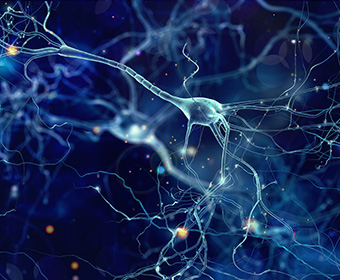
(Oct. 16, 2017) -- How do we know if it was worth the wait in line to get a meal at the new restaurant in town? To do this our brain must be able to signal how good the meal tastes and associate this feeling with the restaurant. This is done by a small group of cells deep in the brain that release the chemical dopamine. The amount of dopamine released by these cells can influence our decisions by telling us how good a reward will be in the future. For example, more dopamine is released to the smell of a cake baking relative to the smell of leftovers. But does waiting change how dopamine is released?
A new study in Cell Reports by Matthew Wanat, assistant professor of biology at The University of Texas at San Antonio (UTSA), sheds light on how dopamine cells in the brain signal the passage of time. Wanat’s study used a technique called voltammetry to record dopamine release in rodents trained using Pavlovian conditioning. This task used two different tones that both predicted the delivery of a food reward. One tone was presented only after a short wait while the other tone was presented only after a long wait. Wanat and colleagues found that more dopamine was released to the short wait tone. These results highlight that when dopamine neurons respond to cues, faster is better.
“The big question that we’re focusing on is to identify the brain signals that influence the decisions we make,” Wanat said. “Many decisions are based upon comparing the value between cues associated with different rewards. There is a lot of evidence to suggest that these dopamine signals and external cues provide useful value-related signals that could inform our decisions to engage in a behavior.”
While Wanat and his collaborators are interested in studying how dopamine release is involved with cues triggering behavior, their work could also inform the understanding of drug addiction, which is closely intertwined with dopamine. Drug addiction can “hijack” the brain regions where dopamine is released. “By figuring out how the dopamine system works in normal and abnormal circumstances, we could potentially identify important changes and the ways that could target the dopamine system to rectify the consequences of those behaviors,” Wanat said.
“A lot has been said about the role of dopamine in reward, but reward is only really important in the context of making choices. Dr. Wanat's experiments allow direct measurement of dopamine acting in the brain during the process of choosing, and reveals how the brain decides the values of our choices,” said Charles Wilson, Ewing Halsell Distinguished Chair in Biology.
Wanat’s overarching research focuses on the brain’s relationships with memory, stress and drug addiction and how those components interact with each other. He is a member of the UTSA Neurosciences Institute, a multidisciplinary research organization for integrated brain studies with the mission to foster a collaborative community of scientists committed to studying the biological basis of human experience and behavior and the origin and treatment of nervous system diseases.
Wanat is one of 40 brain health researchers at UTSA, a group that includes experts in neurodegenerative disease, brain circuits and electrical signaling, traumatic brain injury, regenerative medicine, stem cell therapies, medicinal chemistry, neuroinflammation, drug design and psychology. Together, they are collaborating on complex, large-scale research producing a greater understanding of the brain’s complexity and the factors that cause its decline.
UTSA is recognized as one of the top five young universities in the nation by Times Higher Education.
Read Matthew Wanat’s study, “Dopamine Encodes Retrospective Temporal Information in a Context-Independent Manner.”
Learn more about the UTSA Department of Biology.
Learn more about the UTSA Neurosciences Institute.
Connect with UTSA online at Facebook, Twitter, YouTube, Instagram and LinkedIn.
UTSA Today is produced by University Communications and Marketing, the official news source of The University of Texas at San Antonio. Send your feedback to news@utsa.edu. Keep up-to-date on UTSA news by visiting UTSA Today. Connect with UTSA online at Facebook, Twitter, Youtube and Instagram.
Move In To COLFA is strongly recommended for new students in COLFA. It gives you the chance to learn about the Student Success Center, campus resources and meet new friends!
Academic Classroom: Lecture Hall (MH 2.01.10,) McKinney Humanities BldgWe invite you to join us for Birds Up! Downtown, an exciting welcome back event designed to connect students with the different departments at the Downtown Campus. Students will have the opportunity to learn about some of the departments on campus, gain access to different resources, and collect some giveaways!
Bill Miller PlazaCome and celebrate this year's homecoming at the Downtown Campus with food, games, giveaways, music, and more. We look forward to seeing your Roadrunner Spirit!
Bill Miller PlazaThe University of Texas at San Antonio is dedicated to the advancement of knowledge through research and discovery, teaching and learning, community engagement and public service. As an institution of access and excellence, UTSA embraces multicultural traditions and serves as a center for intellectual and creative resources as well as a catalyst for socioeconomic development and the commercialization of intellectual property - for Texas, the nation and the world.
To be a premier public research university, providing access to educational excellence and preparing citizen leaders for the global environment.
We encourage an environment of dialogue and discovery, where integrity, excellence, respect, collaboration and innovation are fostered.